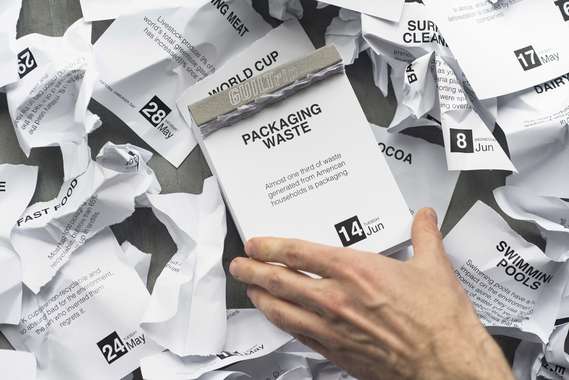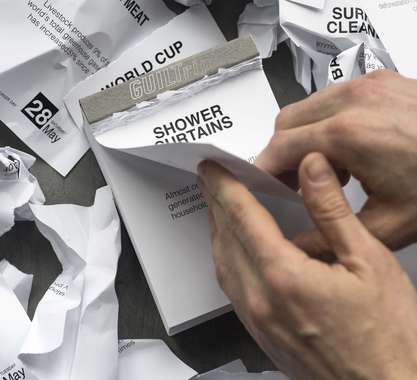GUILTrip
This work has not been commented by curators.
Title
GUILTrip
Headline
A daily activation of eco-guilt
Concept author(s)
Laura Sánchez; Misha Volf; Estefanía Acosta
Concept author year(s) of birth
1985; 1983; 1988
Concept author(s) contribution
Design, production, editing, research, strategy development.
Concept author(s) Country
United States of America
Friendly Competition
Competition category
Visual communication practice
Competition subcategory
static
Competition field
nonacademic
Competition subfield
professional
Subfield description
We work collectively as a design studio and separately in the fields of design publishing, education, and exhibition design.
Check out the Pleasure 2016 outlines of Memefest Friendly competition.
Description of idea
Describe your idea and concept of your work in relation to the festival outlines:
We all do things that are bad for the environment. GUILTrip is a daily tear away calendar that helps us remember each and every one of those things. With 365 days of enlightening, inspiring and altogether quite depressing facts, GUILTrip reminds us of the harmful effects of everyday actions.
Every guilt-ridden page reveals another thing about which to feel compunction. As the year progresses the facts begin to fade, slowly disappearing until only a sole blank page remains. The daily rip then becomes an exercise in progressive futility, designed to overwhelm the user by the hopelessness of the unfolding ecological crisis. Perfect for the desktops of vegans, hybrid car drivers, environmental activists, and anyone who enjoys the perverse pleasure of knowing that despite their virtuous actions, ultimately it’s all for naught.
What kind of communication approach do you use?
The GUILTrip daily calendar is an overwhelming mass of facts. Our communication approach is one of simplicity and density. Each day is marked by the certain and inescapable recognition of one’s unwavering destruction of the earth. Like the coffee and cereal we might enjoy every morning, which is no doubt contributing to the planet’s ultimate demise, the calendar is intended to become a part of one’s morning ritual. Days are paired up with salient facts and tied to collective holidays for maximum individual impact. Considering buying chocolate for your loved one on Valentine’s Day? Better think again. Wrapping up gifts on Christmas Eve? Shame on you — your actions have contributed to the nearly 2 million tons of waste produced by wrapping paper alone during the holiday season. Not to mention the nearly 30 million trees which sacrificed their lives for these gilded ambitions.
What are in your opinion concrete benefits to the society because of your communication?
A simple matter of procedure and daily tactile event, the calendar brings environmental knowledge into an intimate and sensuous relationship with its intended recipient. Like most of our domestic objects, the calendar inserts itself into everyday life.
The power of GUILTrip thus lies not in its ability to shock, surprise, or amaze but instead in its humility — in its ordinariness. With each tear of a page, there is a simple recognition and reenactment of the ways we each take from the earth.
What did you personally learn from creating your submitted work?
We learned to appreciate the many ways that even in our most mundane moments of existence we are highly dependent on the Earth. That to exist is to consume, and to consume is to destroy.
The calendar does not offer alternatives or reprieves, and in this sense implicates us all regardless of our way of life. By including a range of actions — from personal hygiene and travel, to infrastructural and systemic actions— these facts make us consider that there is no one, easy solution to the impending environmental calamity.
Unless our routines of consumption (and destruction) take on an the added phases of stewardship and replenishment, the ecological toll will continue to mount.
Why is your work, GOOD communication WORK?
As the 365 days of facts attest, there’s plenty to feel bad about. But while the calendar may traffic in guilt, it also more subtly asks us to consider how knowledge of one’s misdeeds translates into a commitment to act otherwise.
The GUILTrip invites the user to take on the timekeeping responsibility. Users become active participants in, rather than merely passive observers of, the larger ecological shifts taking place across time.
This action, the daily tearing away and discarding of the proximally recent past becomes an incremental extraction from the materialised corpus of the year. With a severing jerk a daily destruction of the past inaugurates a new, daily present. Allowing the user to literally turn over a new leaf every day, the tear-away invites a sense of optimism and fleeting satisfaction, followed by a subtle, nagging existential dread.
Where and how do you intent do implement your work?
With the content of the calendar so squarely focused on consumption, it is only fitting that it is distributed in the form of a mass produced commodity that’s sold for profit. We would like to make the calendar available for purchase in local bookstores and cafes, as well as online.
Did your intervention had an effect on other Media. If yes, describe the effect? (Has other media reported on it- how? Were you able to change other media with your work- how?)
At this point the project exists as a late-stage prototype, without any significant deployment.






